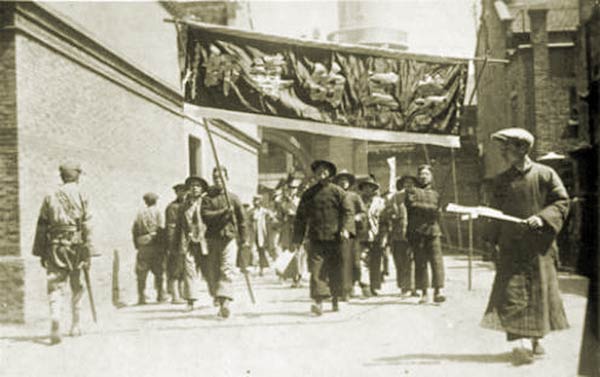At the centenary of the founding of the Chinese Communist Party it is doubtful that its leaders of today will be drawing any lessons from the party’s early history.
Two great revolutions of the twentieth century reinforce the principle that the working class must maintain its political independence in relation to other classes. In 1917 the workers in Russia triumphed after they had rallied in their majority to the Bolsheviks. The Bolshevik’s pursued the idea that the working class, in alliance with the peasants, could take the revolution beyond the overthrow of Tsardom to the overthrow of capitalism. The Mensheviks, the moderate workers’ party, had a different perspective which was that the stage of Russia’s development called for only a bourgeois-democratic revolution, and, therefore, the working class should support the liberal bourgeoisie. John Molyneux summarised the Menshevik line thus:
‘In this scheme of things the role of the workers was a subordinate one. They were to be the troops of the revolution not its leaders, or its victors. Indeed it followed from this theory that the working class had to be restrained lest through demands that were too radical and actions too revolutionary it should frighten the bourgeoisie and throw it into the arms of the autocracy.’
The Russia Revolution validates the principle that the working class must keep its political independence. The same principle is validated by the negative example from the Chinese revolution of 1925-1927 when the working class, and its vanguard in the Chinese Communist Party, misled by the Russian leadership of the Communist International (Comintern), did not hold an independent position and suffered a bloody defeat.
The China of the 1920s was predated upon by all the imperialist powers, which ruled in ‘concessions’ in coastal and river port cities. In the 1920s the majority of China was controlled by warlords until 1928. However, in the south, based in Guangzhou (Canton), the Guomindang Party (Kuomintang, KMT), founded by Sun Yat-sen, established a ‘National’ government and began a military Northern Expedition in 1926 aimed to take control of the whole country from feudal warlordism and imperialism.
A Communist Group was established in Shanghai in 1920 with the help of an emissary from the Comintern. The Group published the weekly The Labourer, the monthly New Youth and a clandestine monthly The Communist. Groups were founded in other cities and in July 1921 a national conference was held which decided to establish the Chinese Communist Party. Let Peng Shuzhi (Peng Shu-tse) take up the story:
‘In 1921-22, the CCP led a series of strikes and won some victories. In light of this, the labor secretariat called the First National Labor Congress to be held in May 1922 in Canton. Those who attended this congress represented 230,000 organised workers. Thus, it is evident that in the space of one short year the CCP had already become the center of the working class movement. … Thus in the spring of 1922, the CCP determined its strategic line toward China’s national democratic revolution.’
The June 1922 CCP congress adopted a manifesto that clearly took the line of working class independence towards the national democratic revolution as this excerpt indicates:
‘If we ourselves put up a concerted struggle for liberation, the workers and poor peasants will flock to the banner of (our) party and the petty bourgeoisie will also link up with us. However, the workers must not become the appendage of the petty bourgeoisie within this democratic united front, but must fight for their own class interests. Therefore it is imperative that the workers be organised in the Party as well as in labor unions. Ever mindful of their class independence, the workers must develop the strength of their fighting organization (in order to) prepare for the establishment of soviets in conjunction with the poor peasantry in order to achieve (the goal of) complete liberation.’
This first programmatic statement of the CCP was inspired by Lenin’s ‘Draft Theses on the National and Colonial Questions’ that had been presented to the Communist International (or Comintern) congress of July 1920. In the theses Lenin said:
‘The Communist International should support bourgeois-democratic national movements in colonial and backward countries only on condition that, in these countries, the elements of future proletarian parties, which will be communist not only in name, are brought together and trained to understand their special tasks, i.e., those of the struggle against the bourgeois-democratic movements within their own nations. The Communist International must enter into a temporary alliance with bourgeois democracy in the colonial and backward countries, but should not merge with it, and should under all circumstances uphold the independence of the proletarian movement even if it is in its most embryonic form … .’
The CCP’s June 1922 manifesto called for a united front with ‘revolutionary elements’ of the Guomindang and revolutionary socialists against foreign domination and the ‘warlords of the feudal type.’ Such a united front was consistent with Lenin’s prescription for the Comintern to enter into ‘a temporary alliance with bourgeois democracy.’ It was also consistent with the Comintern’s independence policy expressed at the Congress of Toilers of the East held in Moscow, January-February 1922. The Guomindang had delegates there. Georgy Safarov, a leader of Comintern work in the Far East, told them ‘We are supporting and will continue to support your struggle in so far as it is a matter of a nationalistic and democratic uprising for national emancipation. But at the same time we shall independently carry on our communist work of organising the proletarian and semi-proletarian masses of China.’
No sooner had the Chinese party adopted a strategic position that was consistent with the Comintern, the Comintern leadership under the presidency of Grigory Zinoviev, abruptly changed policy towards China. In August 1922 a Comintern representative, Henricus Sneevliet (pseudonym Maring), went to China and high-handedly met Guomindang leader Sun Yat-sen before asking the CCP Central Committee to call a special meeting to receive Comintern instructions. These were that CCP members were to enter the Guomindang as individuals, which was in direct contradiction of the policy of independence. According to Peng Shuzhi, a member of the CCP Central Committee, all members attending the meeting opposed the new policy. Sneevliet had to resort to invoking Comintern discipline to get the Central Committee to reluctantly accept the new line.
The fourth Comintern congress, held in November 1922 barely touched upon China, but a speech by Karl Radek, a Russian party and Comintern leader, is telling of the creep towards a Menshevik policy. He patronisingly admonished the Chinese delegates saying:
‘The first task of the Chinese comrades is to focus on what the Chinese movement is capable of. Comrades, you must understand that in China neither the victory of socialism nor the establishment of a soviet republic is on the agenda. Unfortunately, even the question of national unity has not yet been historically placed on the agenda. What we are experiencing in China is reminiscent of the eighteenth century in Europe, in Germany, where the development of capitalism was still so weak that it had not yet given rise to a single unifying national centre. … We have wide perspectives, which you should advocate with all the fire of your youthful Communist convictions. Despite that, our task consists of unifying the real forces taking shape in the working class with two goals: first organising the young working class, and second, establishing a proper relationship between them and the objectively revolutionary bourgeois forces, in order to organise the struggle against European and Asiatic imperialism.’
Given the opposition to joining the Guomindang within the CCP, Zinoviev took the question to the Russian CP politburo in early January 1923. All except Trotsky approved of CCP members joining the Guomindang. Trotsky did not express his view on this issue publicly until 1927, a mistake he regretted. Lenin was by then incapacitated. With the approval of the Russian Party, and the Executive of the Comintern, Zinoviev promulgated on 12 January 1923 a resolution on ‘The relations between the Chinese Communist Party and the Kuomintang’ that endorsed the policy of membership by communists.
There was debate on joining the Guomindang at CCP’s third congress in June 1923. The majority, in awe of the authority of the Soviet government and the Comintern, approved the reversal of the independence policy adopted at the previous year’s congress. Peng Shuzhi wrote:
‘The CCP had turned from its original Bolshevism and moved into the mire of Menshevism. As a matter of fact, the CCP was even worse off than the Russian Mensheviks; at least they were able to maintain their organisational independence, and did not have to join the party of the Russian bourgeoisie, the Constitutional Democrats, whereas the CCP had to join the party of the Chinese bourgeoisie, the KMT [Guomindang], and expressed the ‘hope that all the revolutionary elements of our society will rally to the KMT.’’
The Soviet government sent arms and military advisors to the Guomindang, and CCP members in the Guomindang did Guomindang work. However, a move by Sun Yat-sen to bring CCP members under control ignited a renewal of thinking by CCP leaders on the role of each class in the national-democratic revolution. Chen Duxiu, General Secretary and a founder of the CCP, and Peng Shuzhi came to agree that only the working class could lead the revolution. In January 1925 the CCP’s fourth national congress marked a return to a Bolshevik policy. The congress resolved that the working class was the leader of the national revolution and concentration would be made on building the workers’ movement. The turn to the working class soon bore fruit as railway workers were organised and a strike in Japanese-owned Shanghai cotton mills was won. The CCP convened the Second National Labour Congress on May Day where 166 unions with 570,000 members were represented, which, according to Peng Shuzhi, ‘was imbued with the conviction that the working class should lead the national revolution and in turn carried this idea to the working masses.’
The Shanghai cotton workers struck again to defend its gains and one if their leaders killed. Anti-imperialist demonstrations of students and workers took place. British police fired, killing seven and wounding dozens. This was the May Thirtieth Incident, which started the Second Chinese Revolution (the first being the overthrow of dynastic rule in 1911). Peng Shuzhi relates what happened:
‘… all of Shanghai’s students, workers and merchants went on strike. This became a great wave of anti-imperialism by the “whole people”. In the midst of this wave, the CCP mobilized all of its members and the members of the SYC [youth organisation] to lead the students in organizing the Shanghai Student Federation. At the same time, with the cotton mill unions as a foundation, the Shanghai General Labor Union was established in less than a week. This General Labor Union became the general headquarters in leading the later struggles of the Shanghai workers’ movement.’
‘Under the strong influence of the anti-imperialist movement in Shanghai, evert major city, such as Nanking, Wuhan, and Peking, saw students, workers, and the general public rise up together in strikes and demonstrations; it was a veritable flood of anti-imperialist sentiment in the national liberation movement. Finally, in Canton, the masses of students and workers held a demonstration on June 23 to protest the butchery carried out by British imperialism in Shanghai. The demonstration followed along Shakee Road, and, as it approached Shameen, the imperialist concession area, the British and French military police, strafed the crowd with machine guns. Fifty-seven people were killed and one hundred and seventeen were injured in the famous “Shakee Incident.”’
‘Immediately upon hearing of the butchery by the British imperialists in Canton, the workers in Hong Kong, called a general strike, and many travelled to Canton. It was at this time that the Canton-Hong Kong Strike Committee was established; this became the bastion for the anti-imperialist movement in in South China, initiating the blockade of Hong Kong. This was a grave attack on British imperialism.’
The CCP was now on a collision course with the Russian Soviet government and the Comintern over collaboration with the Guomindang. In October 1925, General Secretary Chen Duxiu, believing that membership of the Guomindang was restraining independence, formally proposed to the central committee that the CCP leave. The Comintern representative headed off Chen’s proposal by holding out the prospect of a leftwing takeover of the Guomindang at its upcoming January 1926 congress. At that congress a number of CCP members were indeed voted into Guomindang leadership positions. However, the CCP and the Comintern were on a fool’s errand; only two months later, Chiang Kai-shek carried out an anti-communist coup within the Guomindang and installed his own military dictatorship. Once again, the policy of CCP-Guomindang collaboration was put up for discussion, and once again Stalin’s representative Mikhael Borodin was able to secure continuation of the policy of subordination to the Guomindang, even though under Chiang Kai-shek’s directives CCP members were barred from leadership positions and the names of all its members in the Guomindang had to be handed over.
At a central committee meeting in July 1926, Chen Duxiu and Peng Shuzhi again put up a motion that the CCP leave the Guomindang, but opposed by the Comintern representative they were unsuccessful. It was agreed that the motion be referred to the Comintern. The Comintern refused to accept it.
By now the Northern Expedition had begun. The CCP mobilised workers and peasants and played a key part in military victories that brought the anti-imperialist forces to Central China, where hundreds of thousands of workers flooded into unions and peasants joined associations in millions. Peng Shuzhi described the situation:
‘In summary, from the time these forces entered the Yangtze Kiang River valley, the worker-peasant movement in Hunan and Hupeh billowed like an angry tide, overturning all social relations. The workers, from strikes for a better life and better working conditions, had become to the verge of attacking the system of private ownership itself. They even went to the point of directly taking over concessions previously controlled by imperialism. The peasants, especially those of Hunan, had gone from struggles aimed at lowering rents and interest rates directly to revolutionary activity to get rid of the landlords and gentry and take over the land. In fact the peasant associations became the governing organizations in most villages. Thus, one can see the new high point which the tide of revolution had reached.’
Chang Kai-shek and the Guomindang, representing the bourgeoisie, were more disturbed by the entry of the masses into a revolutionary movement than they were by the warlords and the imperialists. The Guomindang now became a counterrevolutionary force and set about repression of the workers and peasants in the liberated areas.
Ahead of the northward advance of Chiang Kai-skek’s troops towards Shanghai, on 21 March 1927 the CCP led the Shanghai workers in a successful armed insurrection that destroyed warlord power. However, Comintern policy of collaboration with Chiang Kai-shek, now dictated by Stalin, prevented the CCP from forming a revolutionary city government. Peng Shuzhi states:
‘Even though the CCP had taken Shanghai and gained the support of the entire working class and the majority of the lower petty-bourgeoisie, along with the sympathy of a section of the soldiers, in order to adhere to the Comintern’s policy of a “coalition government of four classes,” the CCP could do nothing but establish a Shanghai provisional government in collaboration with the bourgeoisie.’
Only days later, on 12 April, Chiang Kai-shek began his counterrevolutionary coup in Shanghai. Peng Shuzhi:
‘Thousands of fighting workers and Communist Party members were massacred. Workers’ organizations (unions) were destroyed. Communist Party members were hunted by the reactionaries. … This, then, was Stalin’s final reward for his policy of KMT-CCP collaboration, his unconditional support of the Chiang-led Northern Expedition, his concealment and defense of all of Chiang’s counterrevolutionary activity, and his hopes for Chiang’s success in destroying imperialism and the warlords and completing the struggle for national independence.’
Even after the Shanghai coup, Comintern policy did not change fundamentally. Communist allegiance was transferred from Chiang to the supposed left wing of the Guomindang under Wang Jingwei (Wang Ching-wei), who was installed in the city of Wuhan. Wang’s policy was to hold back the peasants’ land struggle and the workers’ movement. CCP policy of collaboration with the Guomindang was finally proven to be illusory when Wang Jingwei turned on the CCP in July 1927, ordering its members in the Guomindang and its army to leave the CCP or be punished.
Now that the Comintern strategy of collaboration with the bourgeois Guomindang was in tatters, Stalin ordered a 180 degree turn to ultra-left adventurism. The CCP was told to launch uprisings. This was at a time when the revolutionary movement was on the defensive as a result of the former policy of collaboration. There is no need to recount the sorry tale of unprepared heroic failures culminating with the massacre by of thousands of workers and Communists in Guangzhou in December 1927 that marks the end of the 1925-27 revolution.
Had the CCP not been misled by the Comintern under Zinoviev, and later Stalin, the party could have led millions of workers, peasants and small traders to oust the imperialists from the Concessions, which Chiang Kai-shek never did, and establish rule by workers’ council’s, or soviets, in alliance with the peasant masses organised in collectives.
Apart from the principle of the independence of the working class, it should be self-evident from this account that there are other lessons to draw from the CCP’s experience regarding the authority and the democratic processes of international organisations of workers’ parties. The CCP had independent thinkers in its leadership, like Chen Duxiu and Peng Shuzhi, but they could not overcome subservience to the authority of the Russian Communist Party – the party that had led a successful revolution.
Chen Duxiu and Peng Shuzhi both became ardent Trotskyists, but Trotskyism came too late for the Second Chinese Revolution. By 1927 Trotsky attempted to publicly condemn Comintern policy on China, but by now Stalin repressed publication of his writings. In May 1927 Trotsky wrote The Chinese Revolution and the Theses of Comrade Stalin. An extract illustrates the analysis that Chen and Peng had for several years tried to uphold within the CCP:
‘The revolutionary struggle against imperialism does not weaken, but rather strengthens the political differentiation of the classes. Imperialism is a highly powerful force in the internal relationships of China. The main source if this force is not the warships in the waters of the Yangtze Kiang – they are only auxiliaries – but the economic and political bond between foreign capital and the native bourgeoisie. The struggle against imperialism, precisely because of its economic and military power, demands a powerful exertion of forces from the very depths of the Chinese people. Really to arouse the workers and peasants against imperialism is possible only by connecting their basic and most profound life interests with the cause of the country’s liberation.’
Trotsky had enormous authority, second only to Lenin, in the nascent international communist movement. Had the leaders of the early CCP known of Trotsky’s disagreement with Comintern policy from 1923 on, they may well have been able to hold to a position of working-class independence against the pressure to obey the Comintern’s disastrous “instructions”.









